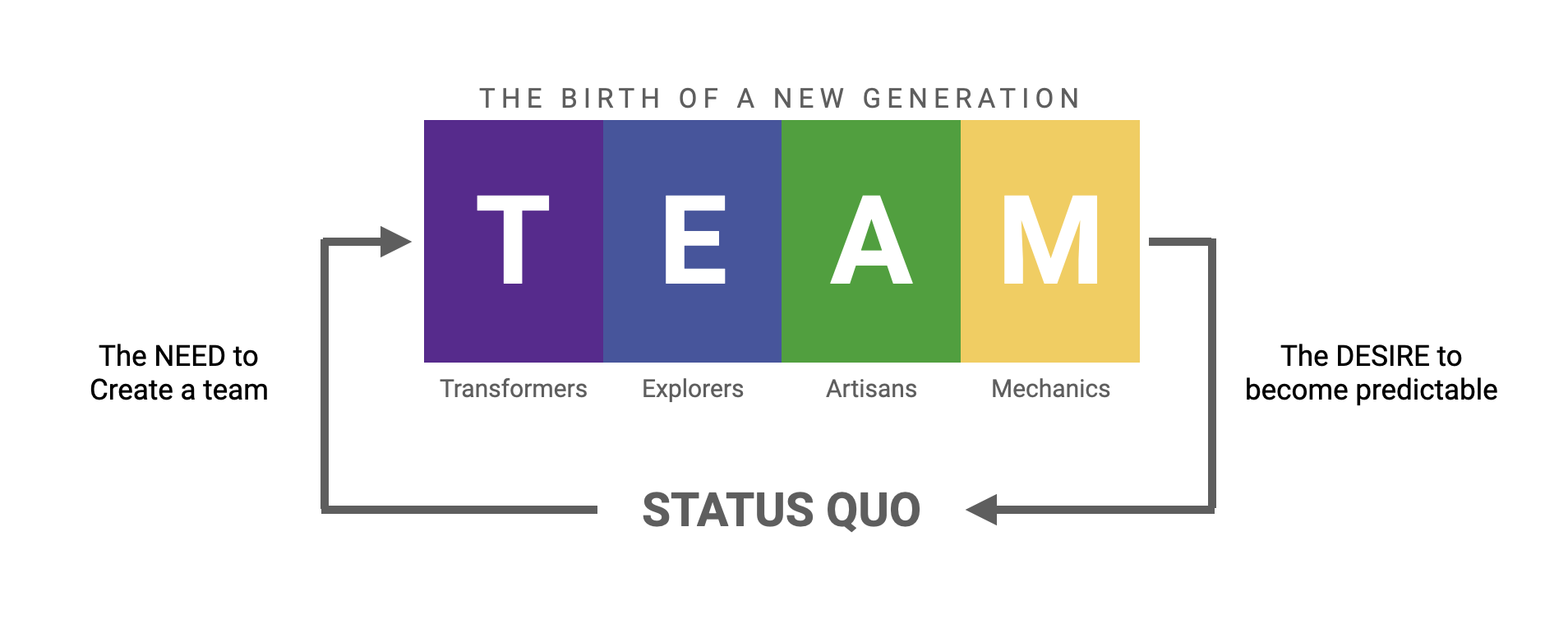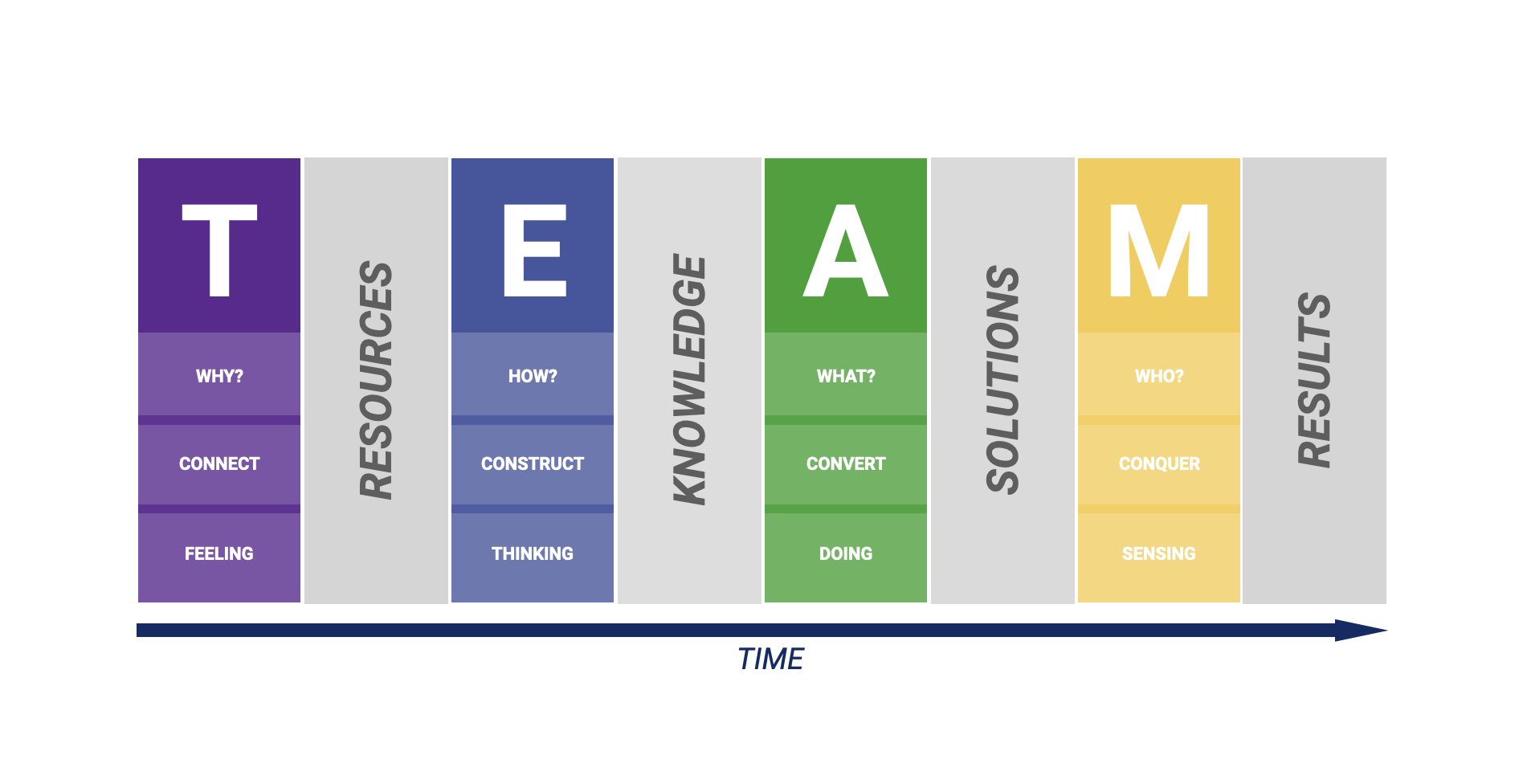
What is the T.E.A.M. Framework?
The last decade we have introduced many new words inside organizations that describe a new way of working. Very familiar words like Design Thinking, Lean UX, Agile, Scrum and Lean Startup. These are all great to describe the work methods and processes but are really bad in giving meaning to some more basic human factors that are associated with teams. Factors like motivation, values, creative skills, and culture. I really believe strongly that these human needs need much more attention in order to make these modern ways of working effectively.
We must acknowledge the human needs within teams much more than we currently do otherwise many of our innovation efforts will result in failure and waste.
So with this post, I introduce to you a framework that helps organizations and teams to better understand the different human needs within different teams that are associated to change and innovation.
Another reason that I have developed this framework is that there is a lot of misconception in the field of teams. We really lack the language to express ourselves properly when we talk about teams. As teams are becoming an increasingly important cornerstone of organizations it is really needed to expand our vocabulary around this topic. With this framework, I discriminate between 4 type of teams. These are archetypical teams. I treat a team like a human in a sense. A unit with shared values operating as one consciousness.
They are to be used as a reference to reflect upon your own teams and help you identify the type of team you are part of, or are interacting with, and what the (human) dynamics of such a team is. In this article I will describe the DNA of these four types and I will share more about the context in which these teams will flourish.
As you can see in the model below, the teams have an order. Each team fits with a different stage of the lifecycle of things. Change starts with Transformers, followed by Explorers, Artisans and Mechanics. Then after Mechanics when the world has become predictable again we enter a state of Status-Quo. A world in which we have automated work and where roles have become jobs. A world where teams dissolve into departments.

Four Type of Teams
Transformers Teams
The first category of teams is T-teams. T-teams can only be formed based on willingness. Transformation, in general, can only be achieved through willingness. A willingness to participate, to imagine, to invest time and resources. This willingness can be found when old “labels” started to fail and erode with people. With labels, I mean words that have meaning or value. Words associated to certain beliefs, business units, technologies, function titles, tools or jobs. So you can say that behind the willingness to transform is sadness and loss. It is about letting go of these old labels. These teams are about developing new potential and freeing up resources. Emotional themes in these teams include uncertainty about identity, loyalty, attention for the existing system(the “old” generation), connecting on values and purpose. Projects run by T-teams are not so much about actually building the vision but about relabeling/repurposing company resources that connect to this new vision/future. Opening a process of relabeling and letting go of old labels is crucial to really effectuate the projects that T-teams work on. T-teams host this relabeling process of employees through “cocoons” like e.g. incubators, off sites and hackathons. As an organization, you need to provide these type of safe spaces where it is safe to shed and be reborn. These new transformed “future proof” resources will be the new foundation on which you will slowly and gradually build your “new house”.
Explorers Teams
E-teams are rare and considered to be responsible for deep innovation and disruption. E-teams change how we look at the world. If you facilitate E- teams in the right way, they can truly do magnificent work and architech and deliver disruptive platforms and IP assets that can grow exponentially. Where with T- teams it is about relabeling, in E- teams it is all about the roles. It is about constructs, structure and plans. It is about developing emerging opportunities. It is about expansion and increase in strength. It is about love for the problem and solution. These teams want to control the future (which is an illusion but don’t tell them :)). These teams are like teenagers that moved into the attic. Independent and stubborn. These teams have plenty of thinkers and have not “landed yet on earth”. They are still playing behind the curtain. Not performing “on stage”. Their work has a lot to do with representation and abstraction. It is roleplaying, enacting. For example, team members represent certain viewpoints. Or in a lab context, you have rebuilt a tiny universe in which you can act out. Where in T- teams we accept everybody’s feelings and opinions, with E- teams you are aligning the team’s point of view. Not by compromise but an elimination of the weakest(survival of the strongest). Working towards a shared truth and consciousness.
Representation goes much further than imagination(which is more for T- teams). Imagination is media, it’s an image in front of you. Representation is more embodied. You experience it, you become part of it. You live through it. You need to have a little bubble(universe) in which you can really go deep down the rabbit hole to understand both the problem and the strength of the solution. Their product is knowledge.
Artisans Teams
A-teams are connected through the material they work with. Maybe they work together in developing a campaign, or a website, maybe they love making music and we call them a band. It can also be a group of people working in the kitchen that love to work with beautiful ingredients. In corporations, it might be a development team that loves to make beautiful code. Team members are craftsmen. They deliver output. They have eye for detail and really love the “art” they make. They are not seeking the truth like E-teams or busy with testing or validating. They are also not that involved with solving problems. These teams produce things that attract. It is beauty that they aspire. Eye for contrast and composition. Balancing “ingredients”. The output of this team is a noun. A unique object. So the creative cycle is designed around the birth of a unique object with a unique name. It is not about iterating and making the object perform better. It is about “showing the world your baby”. These teams can often be disappointed if others don’t recognize the beauty of their art, which is often the case. Therefore it is crucial that these teams really enjoy the process of making the “noun” itself. The satisfaction is in the moment where you work together with the team. Not by the recognition of the customer, press, board of directors, investor or other parties whom you show your beautiful artwork. The Hollywood model is applicable to these teams. The members all know their skill and role. Ready to do their job and play the instrument they love. Be it a brush, a computer, a kitchen knife or a hammer. These teams are not busy with scalability. A-teams have a hard time pricing their work. More and more pricing will be based on rev-share models. So the more traction they are able to generate the more they will earn.
Mechanics Teams
Where E-teams can deliver potential disruptive assets, M- teams can drive results. They are masters in re-ordering and re-shuffling. They work with what is already there and know how to turn that into value. They have a mechanical view. They are operators. They are the masters of making things go frictionless. Once the A-teams have produced their work, it’s up to an M- team to turn that “noun” into “verbs” and even into “numbers”. These teams are busy with changing the messaging, reframing solutions and building trojan horses just to make it all work together. Supply meets demand and the “mess” it creates is solved by or M-teams. Here we move from being just right to also being successful. The sacrifice that needs to be made is the purity of new solutions. In a sense, the solution finally gets a role to play. The solution needs to adapt. Where in E- teams it is all about generating input, with A-teams about output and with M-teams it is all outcome. It helps a lot to be pragmatic, data-driven and a bit opportunistic in nature. They live to make the “machine” work smoothly. Their product is the operation. They think in inputs and outputs. M-teams can start to do value-based pricing. They know exactly what everything is worth. M-teams build your tool stack, do experimentation and continuously interact, learn and grow.

